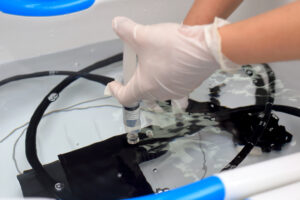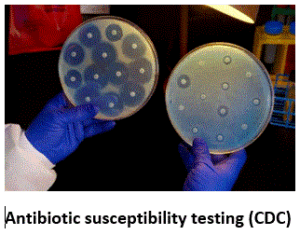This study’s findings suggest that today’s reprocessing practices may not be sufficient to prevent all endoscope-related infections, particularly transmissions of multidrug-resistant organisms by some models of duodenoscopes.
HIGHLIGHTS:
- This study’s findings suggest that today’s reprocessing practices may not be sufficient to prevent all endoscope-related infections.
- Several reports published in the U.S. and Europe document an association between patient exposures to a flexible endoscope and outbreaks of CRE and related multidrug-resistant organisms despite apparent adherence by staff to published endoscope reprocessing practices.
- These findings are not limited to duodenoscopes.
- Risk factors for a “reprocessed” flexible endoscope to remain contaminated are identified.
- Updated guidance is provided to prevent multidrug-resistant bacterial infections.
September 27, 2022 (by: Lawrence F Muscarella, PhD): – Flexible endoscopes are used to perform millions of diagnostic and therapeutic procedures each year in the U.S. The meticulous cleaning and disinfection (or sterilization) of these complex reusable devices — also known as “endoscope reprocessing” — is crucial to public health and the prevention of antibiotic-resistant bacterial infections.
According to the U.S. Centers for Disease Control and Prevention, each year in the U.S. antibiotic-resistant bacteria and fungi are responsible for almost 3 million infections and 35,000 deaths. Based on these data, the CDC in 2019 calculated that “on average, someone in the United States gets an antibiotic-resistant infection every 11 seconds and every 15 minutes someone dies.”
 Gastrointestinal (GI) endoscopes are a type of flexible endoscope. Other examples of a flexible endoscope include bronchoscopes, ear-nose-throat (“ENT”) endoscopes, and urological endoscopes.
Gastrointestinal (GI) endoscopes are a type of flexible endoscope. Other examples of a flexible endoscope include bronchoscopes, ear-nose-throat (“ENT”) endoscopes, and urological endoscopes.
Endoscope reprocessing is a multistep, detail-oriented process that also includes visually inspecting the endoscope for both damage and contamination with bioburden, testing the endoscope for leaks, and safely storing the endoscope according to manufacturer instructions following high-level disinfection or sterilization.
Several publicized outbreak investigations linked a flexible endoscope to infections of carbapenem-resistant Enterobacteriaceae — also known as “CRE” — or related multidrug-resistant organisms. The mortality rates for patients infected with such “superbugs” can be as high as 50%, or higher.
Colonoscopes, duodenoscopes, and gastroscopes are examples of a GI endoscope.
 Expert Infection Prevention Guidance, Consulting Services, and Case Reviews: LFM-Healthcare Solutions, LLC provides medical expertise for healthcare facilities, device manufacturers and the public, specializing in healthcare-associated infections linked to contaminated reusable medical equipment. Value-oriented advice with years of experience and trust.
Expert Infection Prevention Guidance, Consulting Services, and Case Reviews: LFM-Healthcare Solutions, LLC provides medical expertise for healthcare facilities, device manufacturers and the public, specializing in healthcare-associated infections linked to contaminated reusable medical equipment. Value-oriented advice with years of experience and trust.
Objectives: The primary aims of this article are to assess the adequacy of today’s endoscope reprocessing practices, as well as provide updated guidance to prevent a GI endoscope from remaining contaminated and transmitting multidrug-resistant organisms.
Secondary aims include identifying risk factors for a “reprocessed” flexible endoscope to remain contaminated; to compare the relative infection risks of different types of GI endoscopes; and to discuss a three-tiered, risk-based classification scheme to help guide healthcare facilities considering sterilization of a flexible endoscope.
Two other objectives of this study are to list common types of adverse events associated with a GI endoscope and to highlight certain year-to-year trends in the number of FDA adverse events reports describing the contamination of a GI endoscope (with or without associated infection).

Methods: These objectives were achieved primarily by reviewing: (i) recent clinical cases linking a flexible endoscope, particularly a GI endoscope, to infections of CRE or a related multidrug-resistant organism, including published outbreaks; (ii) recent FDA safety alerts and device recalls focusing on actual or potential endoscope contamination; and (iii) adverse event reports submitted to FDA since 2014 that describe endoscope contamination.
Scope, Sources: The sources of the reviewed clinical cases, alerts, recalls and adverse event reports include the FDA’s “MAUDE” (or medical device) database and the FDA’s device recall database.
This abstract focuses primarily on the contamination of GI endoscopes, although the infection risk of other types of flexible endoscopes is also discussed.
Findings: The findings of this study suggest that today’s reprocessing practices may not be sufficient to prevent all endoscope-related infections, particularly transmissions of multidrug-resistant organisms by some models of duodenoscopes.
Duodenoscopes are used to perform a procedure called endoscopic retrograde cholangiopancreatography (ERCP).
In addition to duodenoscopes, this study identified reports linking infections of CRE to gastroscopes and colonoscopes, as well as to bronchoscopes.
FDA recently advised the public about reports linking contamination of a forceps/irrigation plug, which is an accessory component used to control water flow and enable access to the working channel of a urological endoscope, to bacterial infections. Reports have linked flexible intubation endoscopes, too, to multidrug-resistant bacterial infections.
Factors this study found can increase the risk of a “reprocessed” flexible endoscope remaining contaminated and transmitting multidrug-resistant organisms include, among others:
- faulty cleaning of the endoscope;
- the complex physical design of certain endoscope models that may impede effective reprocessing;
- persistent contamination of the endoscope due to formation of inaccessible biofilms;
- endoscope damage; and
- inadequate endoscope maintenance, servicing and/or repair.
Several other reports published in the U.S. and Europe, including by the CDC, document an association between patient exposures to a flexible endoscope and outbreaks of CRE or related multidrug-resistant organisms — despite reported adherence by staff to published endoscope reprocessing guidelines and instructions.
 For example, investigating a CRE outbreak in an Illinois hospital, the CDC reported in 2014 that contamination of the duodenoscope with the NDM-producing Escherichia coli “appeared to persist despite the absence of recognized reprocessing lapses.”
For example, investigating a CRE outbreak in an Illinois hospital, the CDC reported in 2014 that contamination of the duodenoscope with the NDM-producing Escherichia coli “appeared to persist despite the absence of recognized reprocessing lapses.”
This case was a watershed moment: Unlike previously reported outbreaks of bacterial transmission related to a flexible endoscope, this investigation identified no reprocessing breaches or duodenoscope defects.
The next year, investigators in Washington State reported an outbreak of multidrug-resistant bacteria associated with patient exposure to a duodenoscope despite no identified endoscope reprocessing breaches. Duodenoscopes that were sampled after reprocessing were found to harbor bacteria exhibiting the outbreak’s gene sequence profile.
This 2015 report, consistent with the CDC’s earlier 2014 investigation, states that “(e)ven after enhancing endoscope reprocessing with meticulous manual cleaning, enteric bacteria continued to be recovered” from the endoscope. The report concluded that “(r)ecommended reprocessing guidelines are not sufficient.”
Researchers in California investigating a carbapenem-resistant Klebsiella pneumoniae linked to duodenoscopes concluded similarly in 2017 that “(i)t has become increasingly clear that adherence to Food and Drug Administration (FDA)–approved manufacturer cleaning guidelines does not eradicate bacteria from duodenoscopes.”
These findings are not unique to duodenoscopes.
Investigators in Pennsylvania reported in 2016 a CRE cluster associated with gastroscope exposure. No deficiencies in the gastroscope’s reprocessing were observed, according to the report — which concludes that endoscopes less complex than a duodenoscope also “may fail high level disinfection and cause infections.”
In 2015, FDA issued a safety communication focusing on infections associated with reprocessed flexible bronchoscopes. This federal notice disclosed that some recently submitted medical device reports “indicate persistent device contamination despite following the manufacturer’s reprocessing instructions.” Bronchoscopes are less complex in physical design than either a duodenoscope or gastroscope.
Researchers investigating an association between a bronchoscope and clusters of multidrug-resistant Pseudomonas aeruginosa and carbapenem-resistant K. pneumoniae in 2014 (and again in Pennsylvania) described the accumulation of proteinaceous debris in a endoscope “despite compliance with manufacturer’s recommended reprocessing procedures.” Culture of the implicated bronchoscope was positive for the bacteria.
Other findings of this study include year-to-year trends in the number of adverse event reports describing endoscope contamination.
 A previously published analysis by this abstract’s author found that the number of adverse event reports submitted to FDA in 2021 describing the contamination of a colonoscope, duodenoscope or gastroscope, compared to the respective number submitted seven years earlier in 2014, increased significantly for each of these endoscope types.
A previously published analysis by this abstract’s author found that the number of adverse event reports submitted to FDA in 2021 describing the contamination of a colonoscope, duodenoscope or gastroscope, compared to the respective number submitted seven years earlier in 2014, increased significantly for each of these endoscope types.
This study’s review of published outbreaks and other clinical cases, consistent with the published findings of others, indicates that compared to colonoscopes and gastroscopes, duodenoscopes (at least those conventional models featuring a fixed endcap), pose the highest relative infection risk.
Regarding device mishaps, the study on which this abstract is based found that these three types of GI endoscopes share certain adverse events related to reprocessing. For example — in addition to cases linking colonoscopes, duodenoscopes and gastroscopes to infections of CRE — medical device reports were identified describing practitioners during the endoscopic procedure finding in the working channel of each of these endoscopes a therapeutic accessory (e.g., a stent, clip) that had been used previously on a different patient.
While FDA recently issued several safety correspondence with recommendations to reduce the contamination rate and infection risk associated with duodenoscopes (in 2015 and 2019), bronchoscopes (in 2015 and 2021, among other years) and urological endoscopes (in 2021), federal notices providing updated guidance for reducing the risk of gastroscopes (or colonoscopes) remaining contaminated after reprocessing and potentially exposing patients to multidrug-resistant organisms including CRE, including gastroscope models featuring an ultrasound transducer and elevator mechanism, have not been published.
 Infection Prevention Expertise, Scientific Affairs, and White Paper Authorship: LFM-Healthcare Solutions, LLC provides medical expertise for healthcare facilities, manufacturers and the public, specializing in healthcare-associated infections linked to contaminated reusable medical equipment.
Infection Prevention Expertise, Scientific Affairs, and White Paper Authorship: LFM-Healthcare Solutions, LLC provides medical expertise for healthcare facilities, manufacturers and the public, specializing in healthcare-associated infections linked to contaminated reusable medical equipment.
Discussion, Recommendations: Updated guidance is provided to reduce the risk of a flexible endoscope infecting patients with CRE or a related multidrug-resistant organism, including the recommendation that healthcare facilities complete the transition from using older conventional duodenoscope models with a fixed endcap to using newer, more novel duodenoscope models that either feature a single-use component or are fully disposable.
Although FDA recently reported that duodenoscopes featuring a disposable component can reduce the infection risk (compared to the older conventional models), these newer models are not panaceas, and appropriate measures can be adopted to improve patient safety.
More specifically, this review identified submitted FDA reports describing two specific adverse events associated with the use of a newer duodenoscope model featuring a single-use endcap:
- detachment of the endcap, causing it to fall off into the patient’s GI tract, oral cavity or airway; and
- mucosal injuries in the esophagus, stomach, and duodenum, including lacerations (sometimes with associated bleeding). The risk of such mucosal injuries can reportedly increase during activation of suction when withdrawing the duodenoscope.
Staff training and education is crucial to prevent these two adverse events, including review of the manufacturer’s instructions and user manual to ensure the safe use of the duodenoscope (e.g., when suctioning) and the proper attachment of the disposable endcap prior to the ERCP procedure.
Conventional duodenoscopes with a fixed endcap are no longer marketed and sold in the U.S. Nevertheless, a March study by a duodenoscope manufacturer assessing the contamination rates of reprocessed duodenoscopes in non-outbreak settings confirmed that “high-concern” organisms can be recovered from these devices (at least of the two studied duodenoscope models featuring a fixed endcap).
Several factors can increase the risk of a flexible endoscope remaining contaminated after reprocessing, including endoscope damage. Corresponding actions intended to reduce the infection risk associated with each of these factors include:
- the continued development and marketing of novel endoscope designs that enhance (or eliminate) reprocessing;
- enhanced focus on staff training and education; and
- maintaining and servicing the endoscope according to manufacturer instructions.
Additional updated endoscope-related guidance includes healthcare facilities considering adoption of at least one of four “supplemental measure,” first published by FDA in 2015 and which include sterilization, to enhance the reprocessing of duodenoscopes (including likely also the reprocessing of the newer models with a disposable endcap). Application of these supplemental measures to improve the safety of other types of flexible endoscopes may also be considered (consistent with the device’s labeling, as clinically warranted, and when feasible).

FDA recommends sterilization of semi-critical devices, which include flexible endoscopes and GI endoscopes, whenever feasible. According to the agency, “sterilization has a greater safety margin than high-level disinfection.”
Even more relevant today in response to the significant number of recently submitted adverse event reports linking infections of multidrug-resistant bacteria to a flexible endoscope, this article’s findings suggest healthcare facilities consider reviewing a three-tiered classification scheme, first published by this abstract’s author in 2019, to help guide healthcare facilities considering sterilization of a flexible endoscope.
This scheme categorizes flexible endoscopes based on their assessed relative risk (i.e., low, intermediate, high) of transmitting a multidrug-resistant organism. Some reports suggest sterilization may be required to terminate “superbug” outbreaks linked to higher-risk endoscopes — for example, duodenoscopes, although high-level disinfection may be adequate to prevent other, lower-risk flexible endoscopes (e.g., hysteroscopes, “channel-less” endoscopes, or transesophageal echocardiography probes), from transmitting multidrug-resistant organisms. According to some investigators, the complex design of duodenoscopes “should require sterilization.”
Adverse event reports recently submitted to FDA suggest that today’s risk of a gastroscope remaining contaminated after reprocessing and exposing patients to multidrug-resistant organisms may be under-recognized. Efforts to increase awareness of this specific risk is encouraged.
For example, the findings presented in this abstract suggest FDA consider issuing a safety communication, as the agency has for duodenoscopes, bronchoscopes and urological endoscopes, that would provide updated guidance to enhance reprocessing and reduce the risk of gastroscopes remaining contaminated with multidrug-resistant organisms. Gastroscope models featuring an elevator mechanism, similar to duodenoscopes, can be challenging to clean.
Other adverse event reports suggest the continued importance of reprocessing staff remaining vigilant about, and continuing to place heightened focus on, meticulously cleaning not only the elevator mechanism of duodenoscopes and ultrasound gastroscopes, but also the air/water channels and nozzle of GI endoscopes (particularly colonoscopes) consistent with manufacturer instructions.
While this abstract’s updated guidance focuses primarily on improving the safety of GI endoscopes, some of its recommendations may also be applied (as clinically warranted and when deemed practical) to reduce the risk of other types of flexible endoscopes remaining contaminated after reprocessing and transmitting multidrug-resistant organisms, including bronchoscopes, cystoscopes, and ureteroscopes.
Additional recommendations designed to reduce today’s risk of a flexible endoscope transmitting CRE and related multidrug-resistant organisms include:
- continued advancements in the designs of flexible endoscopes that enhance reprocessing;
- reviewing the endoscope’s instructions to ensure strict compliance with the manufacturer’s recommended servicing and preventative maintenance program; and
- confirming that the medical facility’s relevant reprocessing policies and procedures are up-to-date and comply with at least one recently published endoscope reprocessing guideline, such as the 2021 “multi-society” guideline for reprocessing GI endoscopes and accessories or a comparable evidence-based, detailed endoscope reprocessing guideline.
(This list of recommendations is incomplete. Please refer to the more comprehensive article which will be published soon and on which this abstract is based.)
Summary, Conclusions: This study’s findings suggest, consistent with the findings of others, that today’s reprocessing practices are not failsafe and may not be sufficient to prevent all endoscope-related infections, particularly ERCP-related infections of CRE and other multidrug-resistant organisms.
Several reports published in the U.S. and Europe document an association between patient exposures to a flexible endoscope and infections of multidrug-resistant organisms despite apparent adherence by staff to published endoscope reprocessing guidelines and instructions. These findings are not limited to duodenoscopes.
Several factors can increase the risk of a flexible endoscope remaining contaminated after reprocessing, including endoscope damage. FDA advises that healthcare facilities to consider sterilization when feasible because this more robust process “has a greater safety margin than high-level disinfection.”

Highlighting certain year-to-year trends, a previously published analysis by this abstract’s author found that the number of adverse event reports submitted to FDA in 2021 describing the contamination of a colonoscope, duodenoscope or gastroscope, compared to the respective number submitted seven years earlier in 2014, increased significantly for each of these three endoscope types.
Colonoscopes, duodenoscopes and gastroscopes share certain reprocessing-related adverse events, including reports linking each to infections of CRE. This article recommends FDA consider the merit of issuing a safety communication that would provide updated guidance to enhance reprocessing and reduce the risk of gastroscopes remaining contaminated with multidrug-resistant organisms.
Other updated recommendations include continuing to encourage the development of endoscope designs that enhance cleaning. Healthcare professionals are urged to review periodically FDA’s MAUDE and recall databases to identify newly recognized patient harms, particularly infection risks, associated with use of a flexible endoscope.
Finally, management policies and programs committed to continuing education and periodic training of healthcare staff to ensure reprocessing competencies, and that include periodic monitoring or auditing of reprocessing practices to confirm compliance with manufacturer instructions, are important cornerstones of public health.
Note #1: “Linking” or ”associating“ an endoscope with an infection or outbreak does not confirm the device transmitted or otherwise caused the infection, as one or more other factors could be, in part or solely, responsible. More data would be required to conclude more definitively that a device caused an infection.
Note #2: FDA states the following: “Although (medical device reports) are a valuable source of information, this passive surveillance system has limitations, including the potential submission of incomplete, inaccurate, untimely, unverified, or biased data.”
Abstract by: Lawrence F Muscarella, PhD. Copyright (2022). LFM Healthcare Solutions, LLC. All rights reserved. Dr. Muscarella is the president and founder of LFM Healthcare Solutions, LLC, an independent quality improvement company. Click here for a list of his quality improvement healthcare services. E: Larry@LFM-HCS.com. Twitter: @MuskiePhD [LFM-ver-1.03]